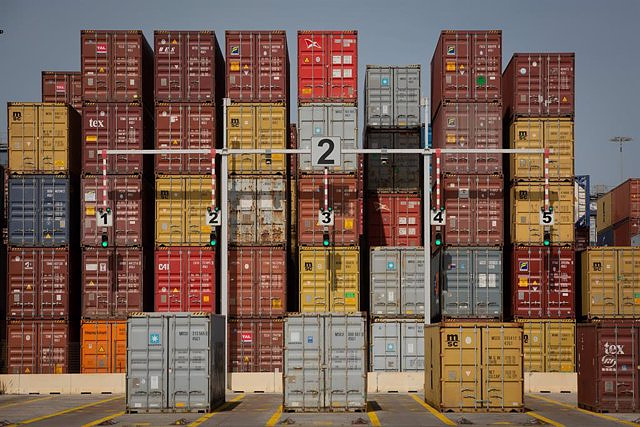The energy deficit reached 5,894.1 million in the first two months of the year, 16% less than in the same period of 2022
The trade deficit stood at 6,420.6 million euros in the first two months of the year, which represents a decrease of 40.4% compared to that registered in the same period of 2022, according to data published this Thursday by the Ministry Industry, Commerce and Tourism.
The report on foreign trade for February reflects that the energy deficit in the first two months of this year fell to 5,894.1 million euros, compared to 6,984.5 million in the same period of the previous year, while the balance was not energy showed a deficit of 526.5 million euros, less than the 3,790.2 million of 2022.
Spanish merchandise exports increased by 12.8% up to February over the same period in 2022, with 63,751.1 million euros, a record high for the period. Imports, on their side, rose by 4.3%, to 70,171.7 million euros, also an all-time high.
"The Spanish foreign sector continues to show dynamism and trade flows remain at historical figures, which shows the excellent positioning of our companies in international markets", highlighted the Minister of Industry, Trade and Tourism, Héctor, in a statement. Gomez.
In volume, exports decreased by 0.5% year-on-year, since their approximate prices by unit value indices increased by 13.3%, and imports fell by 3.3% year-on-year, due to their prices rising by 7.8%
Thus, the coverage rate --quotient between exports and imports-- stood at 90.9%, that is, 6.9 percentage points more than that registered in January-February 2022 (84% with provisional data).
GREATER WEIGHT OF EXPORTS OF CHEMICAL PRODUCTS
The main sectors in terms of weight over total exports in the period were chemical products, which represented 19.1% of the total and increased 15.9% year-on-year. They are followed by capital goods (17.5% of the total and increased 20.9% year-on-year), food, beverages and tobacco (17.2% of the total and increased 9.4% year-on-year) and the automotive sector (13, 0% of the total and grew by 20.3% year-on-year).
The sectors that contributed the most to the annual variation rate of exports in the period (12.8%) were capital goods (3.4 points), chemical products (3 points), automobile sector (2.5 points) and energy products (1.9 points). At the opposite extreme, the sectors that contributed negatively in the period were: raw materials (contribution of -0.2 points) and non-chemical semi-manufactures (-0.2 points).
EXPORTS TO THE EU RISE BY 15.5%
Among the main economies of the European Union, exports from Germany (9.4%) and France (9.7%) also grew. Outside the European Union, exports from the United Kingdom increased by 15.9% year-on-year, those from the United States increased by 8.7% year-on-year, those from China by 0.9% year-on-year, and those from Japan by 5.1% year-on-year.
Spanish exports to the European Union-27 in the period represented 64.5% of the total, higher than the 63% in the same period of the previous year and increased by 15.5% year-on-year. For its part, those directed to the euro zone accounted for 56.2% of the total and grew by 14% year-on-year.
By country, the cumulative increase up to February in exports to Germany (16.7%), Italy (15%), France (14.5%) and Portugal (5.6%) stands out. In the rest of Europe, sales to Turkey increased by 25.8% and sales to the United Kingdom increased by 6.7%.
Exports to third destinations increased by 8.3% year-on-year in this period, and account for 35.5% of the total, highlighting the growth of exports to Oceania (35.3%), Latin America (19%), South America North (10.3%), the Middle East (2.8%) and Asia excluding the Middle East (2.1%), compared to the declines in Africa (-2.6%).
By country, the increases in Singapore (44.7%), Brazil (39.7%), Australia (34.4%), South Africa (26.1%), United Arab Emirates (21.9%), India (18.9%), Egypt (18.8%), Indonesia (15.2%), United States (13.3%), Morocco (14.7%) and Mexico (13.2%). On the opposite side, Algeria (-94.9%), Nigeria (-22.9%), Argentina (-19%), South Korea (-12.9%), Canada (-12%), Chile (-9.5%), China (-6.7%) and Peru (-0.8%).
THE BALEARIC ISLANDS REGISTERED THE GREATEST INCREASE IN EXPORTS
By autonomous community, the community that experienced the highest year-on-year variation rate of its exports in the period was the Balearic Islands (64%), followed by the Community of Madrid (25.8%) and the Principality of Asturias (25.2%). . On the other hand, the greatest year-on-year decreases were registered in the Canary Islands (-11.4%), Galicia (-3.6%) and Cantabria (-1.4%).
In the analysis of the contributions to the interannual variation rate of total exports (12.8%), the community with the greatest positive contribution was Catalonia, with 4.7 percentage points, whose exports represented 25.7% of the total and grew by 19.3% year-on-year. It was followed by the Community of Madrid, with a contribution of 3.5 points and whose exports, 15.2% of the total, increased by 25.8% year-on-year.
The Communities with the greatest negative contributions were Galicia, with -0.3 points (6.7% of total exports, fell 3.6% year-on-year) and Canarias, with -0.1 points (0.6% of total , decreased by 11.4% year-on-year).

 Exploring Cardano: Inner Workings and Advantages of this Cryptocurrency
Exploring Cardano: Inner Workings and Advantages of this Cryptocurrency Seville.- Economy.- Innova.- STSA inaugurates its new painting and sealing hangar in San Pablo, for 18 million
Seville.- Economy.- Innova.- STSA inaugurates its new painting and sealing hangar in San Pablo, for 18 million Innova.- More than 300 volunteers join the Andalucía Compromiso Digital network in one month to facilitate access to ICT
Innova.- More than 300 volunteers join the Andalucía Compromiso Digital network in one month to facilitate access to ICT Innova.-AMP.- Ayesa acquires 51% of Sadiel, which will create new technological engineering products and expand markets
Innova.-AMP.- Ayesa acquires 51% of Sadiel, which will create new technological engineering products and expand markets Mulino, dolphin of former President Martinelli, wins the presidential elections in Panama
Mulino, dolphin of former President Martinelli, wins the presidential elections in Panama The prosecutor who asked to investigate the complaint of Ayuso's partner against two prosecutors for revealing secrets is removed
The prosecutor who asked to investigate the complaint of Ayuso's partner against two prosecutors for revealing secrets is removed The PSC would win the Catalan elections with between 40 and 42 seats, followed by Junts (35-37) and ERC (21-23)
The PSC would win the Catalan elections with between 40 and 42 seats, followed by Junts (35-37) and ERC (21-23) The Israeli Army asks Palestinians to leave Rafah "immediately" in the face of an imminent offensive
The Israeli Army asks Palestinians to leave Rafah "immediately" in the face of an imminent offensive How Blockchain in being used to shape the future
How Blockchain in being used to shape the future Not just BTC and ETH: Here Are Some More Interesting Coins Worth Focusing on
Not just BTC and ETH: Here Are Some More Interesting Coins Worth Focusing on A sensor system obtains the fingerprint of essential oils and detects if they have been adulterated
A sensor system obtains the fingerprint of essential oils and detects if they have been adulterated Faraday UPV presents the 'Origin' rocket to exceed 10 km of flight: "It is the beginning of the journey to space"
Faraday UPV presents the 'Origin' rocket to exceed 10 km of flight: "It is the beginning of the journey to space" The Generalitat calls for aid worth 4 million to promote innovation projects in municipalities
The Generalitat calls for aid worth 4 million to promote innovation projects in municipalities UPV students design an app that helps improve the ventilation of homes in the face of high temperatures
UPV students design an app that helps improve the ventilation of homes in the face of high temperatures A million people demonstrate in France against Macron's pension reform
A million people demonstrate in France against Macron's pension reform Russia launches several missiles against "critical infrastructure" in the city of Zaporizhia
Russia launches several missiles against "critical infrastructure" in the city of Zaporizhia A "procession" remembers the dead of the Calabria shipwreck as bodies continue to wash up on the shore
A "procession" remembers the dead of the Calabria shipwreck as bodies continue to wash up on the shore Prison sentences handed down for three prominent Hong Kong pro-democracy activists
Prison sentences handed down for three prominent Hong Kong pro-democracy activists ETH continues to leave trading platforms, Ethereum balance on exchanges lowest in 3 years
ETH continues to leave trading platforms, Ethereum balance on exchanges lowest in 3 years Investors invest $450 million in Consensys, Ethereum incubator now valued at $7 billion
Investors invest $450 million in Consensys, Ethereum incubator now valued at $7 billion Alchemy Integrates Ethereum L2 Product Starknet to Enhance Web3 Scalability at a Price 100x Lower Than L1 Fees
Alchemy Integrates Ethereum L2 Product Starknet to Enhance Web3 Scalability at a Price 100x Lower Than L1 Fees Mining Report: Bitcoin's Electricity Consumption Declines by 25% in Q1 2022
Mining Report: Bitcoin's Electricity Consumption Declines by 25% in Q1 2022 Oil-to-Bitcoin Mining Firm Crusoe Energy Systems Raised $505 Million
Oil-to-Bitcoin Mining Firm Crusoe Energy Systems Raised $505 Million Microbt reveals the latest Bitcoin mining rigs -- Machines produce up to 126 TH/s with custom 5nm chip design
Microbt reveals the latest Bitcoin mining rigs -- Machines produce up to 126 TH/s with custom 5nm chip design Bitcoin's Mining Difficulty Hits a Lifetime High, With More Than 90% of BTC Supply Issued
Bitcoin's Mining Difficulty Hits a Lifetime High, With More Than 90% of BTC Supply Issued The Biggest Movers are Near, EOS, and RUNE during Friday's Selloff
The Biggest Movers are Near, EOS, and RUNE during Friday's Selloff Global Markets Spooked by a Hawkish Fed and Covid, Stocks and Crypto Gain After Musk Buys Twitter
Global Markets Spooked by a Hawkish Fed and Covid, Stocks and Crypto Gain After Musk Buys Twitter Bitso to offset carbon emissions from the Trading Platform's ERC20, ETH, and BTC Transactions
Bitso to offset carbon emissions from the Trading Platform's ERC20, ETH, and BTC Transactions Draftkings Announces 2022 College Hoops NFT Selection for March Madness
Draftkings Announces 2022 College Hoops NFT Selection for March Madness
























